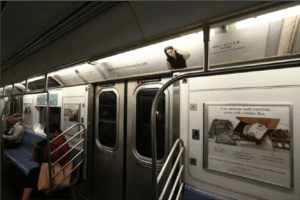Women’s apparel retailer MM.LaFleur wants to reach prospective customers—urban, professional women—where they’re already looking. And one place it is seeking to capture their attention on their daily commutes with ads in subway stations.
The retailer, No. 868 in the Internet Retailer 2018 Top 1000, launched its first outdoor ad campaign in Boston and New York City subway cars last year; the Boston campaign ran from July 5-Aug. 20, and the New York campaign ran from July 24-Aug. 20. And it recently launched a follow-up campaign in Chicago’s L system.
Outdoor ads offer MM.LaFleur a unique location to deliver its brand message, says Jen Braunschweiger, the retailer’s vice president of brand marketing. “We’re a fashion company that designs clothes for professional working women who are busy and overcommitted,” she says. “We’re interested in meeting her with our brand message wherever she is. One place we can communicate with her is on her commute.”
Outdoor ads are one piece of MM.LaFleur’s marketing mix, which includes a standard array of search, display and social media ads. However, outdoor ads are distinct because they provide the retailer with a means of cutting through the digital marketing clutter that bombards consumers whenever they go online, Braunschweiger says.
“The goal is simple: We want to help women who need us, to find us,” she says.

MM.LaFleur ran an ad campaign in the New York City subway system in July and August 2017. It is currently running a campaign in Chicago’s L system.
MM.LaFleur is hardly alone among online retailers in leveraging outdoor ads. Worldwide spending on outdoor, or out-of-home, advertising—a category that encompasses ads on billboards, subways and in shopping malls—is expected to reach $38 billion this year, a 3% jump over last year and a 35% increase since 2010, according to data from ad measurement company Zenith.
Those gains stand in stark contrast to other offline channels, such as magazine and newspaper advertising, which are expected to decrease 7.2% and 6.8%, respectively. And it is outpacing TV and radio advertising, which is expected to grow 1.8% and 1.2%, respectively (online advertising, for the sake of comparison is expected to increase 11.5%, according to the forecast).
For MM.LaFleur, outdoor ads have been more effective than other channels, according to an analysis of its Boston and New York campaigns by digital marketing firm Good Apple that leveraged the firm’s multichannel attribution model, which seeks to assign credit for each touch point that leads a shopper to make a purchase. The analysis found that the subway ads drove a 30% more efficient cost per visit than the digital ads the retailer ran on search, social, podcasts and YouTube. And the ads significantly increased MM.LaFleur’s brand awareness; the number of branded searches by consumers in New York City jumped 140% during the campaign compared with the pre-campaign average and the number of branded searches in Boston soared 170% compared with the pre-campaign average.
Those results have helped convince Braunschweiger that outdoor ads are a key piece of its marketing mix. “Finding the right marketing mix is like putting together a meal,” she says. “You can’t use just one ingredient, you need balance.”
Favorite